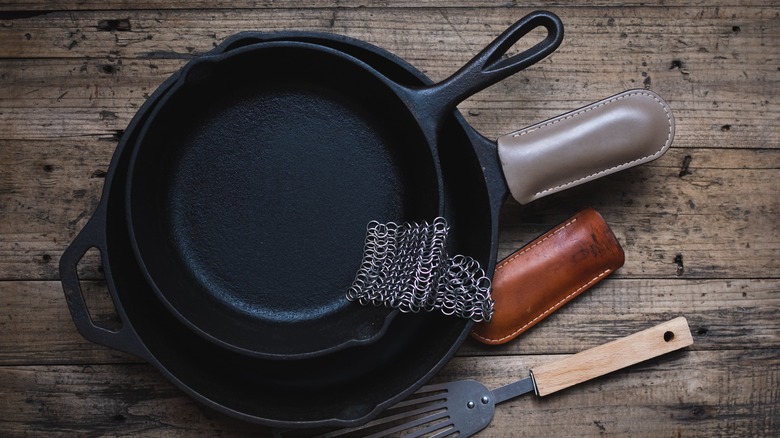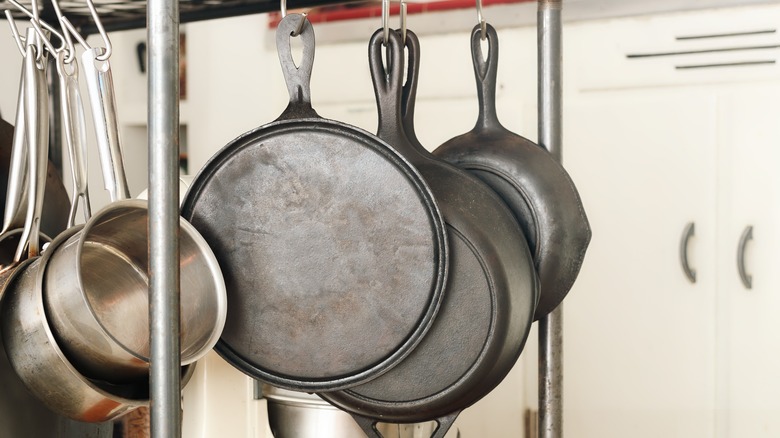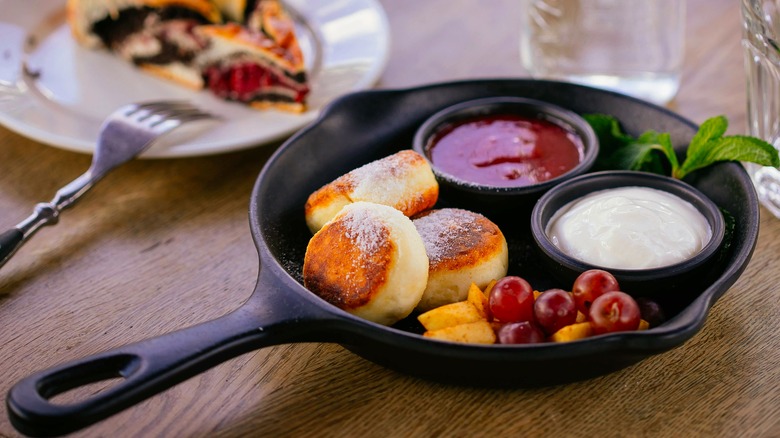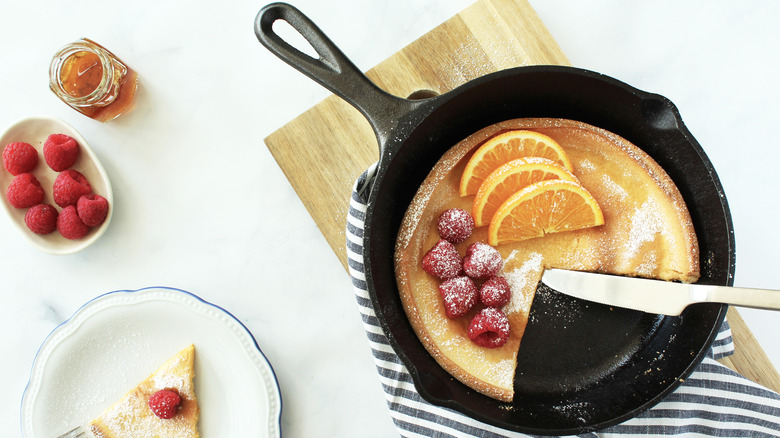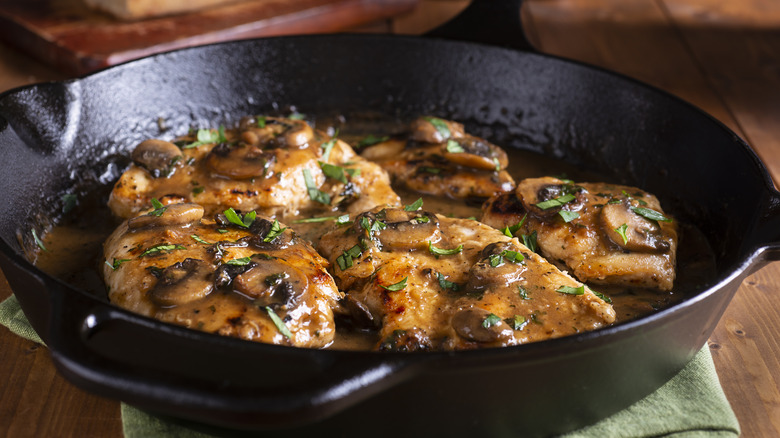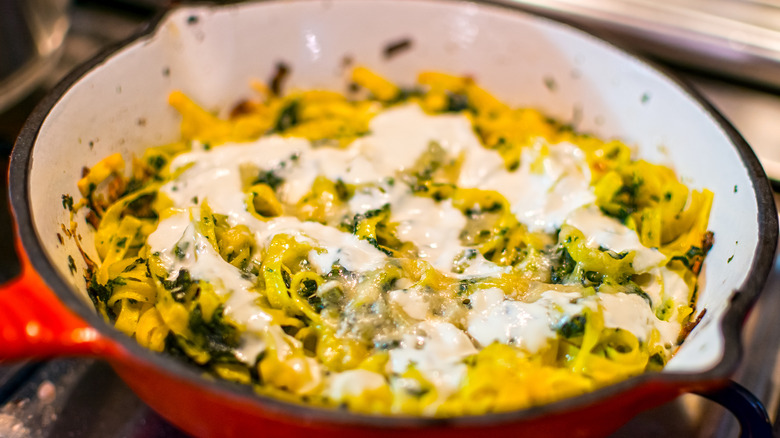5 Tips You Need For Choosing The Best Cast-Iron Skillet
We may receive a commission on purchases made from links.
A cast-iron skillet is often called a "workhorse" of the kitchen, and it's no wonder because you can cook a vast array of recipes in a cast-iron pan, ranging from a whole roast chicken to a Dutch baby. Cast-iron cookware has been around for thousands of years, and since then, little has changed in how it's made. Cast iron had its heyday in the 18th and 19th centuries, but its popularity waned as new materials, like aluminum and stainless steel, were introduced in the 20th century.
Today, cast iron is all the rage again for many reasons. Although cast iron takes longer to heat up than other metal cookware, it retains heat longer than other skillets. Cast iron is also naturally nonstick, so food releases just as well as a chemically coated nonstick pan does, and because of how it's made, a cast iron skillet is extraordinarily durable for many years. Finally, whereas well-made stainless steel fry pans can cost about $100, a superb cast-iron skillet can go for a mere $20. But before you race out to buy one, we've put together five tips that will help you choose the best cast-iron skillet.
Always check the weight
If you held a cast iron skillet in one hand and a stainless steel skillet in the other, you'll immediately notice that the cast iron skillet is much heavier. A 10-inch stainless steel pan weighs around three to three-and-a-half pounds, while a 10-inch cast iron pan can weigh five-plus pounds, and a 12-incher can weigh around eight to 10 pounds. Cast iron is heavier than other metal cookware because of its composition. Primarily made from iron, cast iron also has 2% to 4% carbon, 1% to 3% silicone, and sometimes small amounts of manganese, sulfur, and phosphorus that help strengthen the alloy and facilitate the casting process. Science aside, what all this means is that a cast-iron skillet has increased density, and thus more weight, and can reach and maintain high temperatures longer than other metal cookware, which is what you want for cooking a perfectly seared steak.
Because of its weight, a cast-iron skillet can be difficult to move around on a stovetop, so it's not ideal for stir-frying or flipping an omelet, and washing it will also be challenging. Thinner and lighter cast-iron pans are available, but they may not retain heat as well, need to be repeatedly seasoned, and are not dishwasher-friendly. So before buying one, it's a good idea to test its weight in person, comparing pans to find which is best for you to lift and move around.
Look for a longer handle
Because the cast-iron skillet's weight limits maneuverability, the length of its handle is important to facilitate moving it around the stovetop and in and out of the oven. Most cast-iron skillets have rather short handles because longer handles tend to break off when the pan is cast. To alleviate the stress of lifting the skillet with a blazing-hot short handle, some pans have a helper handle opposite the main handle, which ensures you get a firm grip with heat-resistant pot holders.
It can be tricky, though, to find a cast-iron skillet with a long handle, so an easy fix that's often recommended is a silicone cover, which slips snugly over the stubby handle and protects your hands from high temperatures. Silicon handle covers, however, are not meant to be used while the pan is in the oven, and should only be put on when you're taking the skillet out of the oven.
Always buy pre-seasoned
Over time, and with proper maintenance, a cast-iron pan develops a natural nonstick patina. This "seasoning" isn't a manufactured coating like Teflon; it's bonded to the pan's surface by a complex chemical process and won't chip or flake away as Teflon can. But to retain their nonstick ability, many traditional and vintage cast-iron products need to be seasoned once a month by wiping their surfaces with a light coating of unsaturated oil, like canola oil, and then heating them in the oven at a temperature that's a little higher than the oil's smoke point.
Maintenance isn't as grueling with contemporary cast-iron pans, since most are now pre-seasoned. It's still advised, however, that a pre-seasoned pan should be seasoned before first use, and after that, once washed and thoroughly towel-dried (cast iron can rust when it's air-dried), a little wipe of oil will keep the seasoning protected. Cooking oil for frying or searing also improves the seasoning, so it's recommended that you use your skillet regularly.
Buy a 10- to 12-inch pan
Cast-iron skillets come in many sizes from a tiny 4-inch specialty pan to a 17-inch camping pan that weighs in at 14 pounds. But the larger the skillet, the more unwieldy it is to work with, so before you decide on what size skillet to buy, consider what you might cook in it and for how many people. For example, braising recipes often call for browning meat or vegetables, and you need a large enough pan so the meat browns rather than steams. The two most popular sizes of cast-iron pans are 10 to 10.25 inches for one to two people and 12 inches for two to four people.
The size of your stove burners is also an important factor in deciding which is the right size skillet for you. Once hot, cast iron retains heat, but despite popular belief, it actually doesn't conduct heat well, and hot spots can develop where the pan comes in contact with the flame. Subsequently, a skillet that's too large for a burner won't heat evenly. So in the end, it may be better to go with a smaller size.
Consider an enameled pan
If you're able and willing to splurge, then consider an enameled cast-iron skillet. It will set you back a bit, but you're paying for the convenience of not having to season it or worrying that it will rust. The enamel coating is non-reactive, which means you can cook acidic foods, like tomatoes or citrus fruits, that can eventually corrode cast iron, which in turn destroys the seasoning and leaches metal into food. The enamel-coated cast-iron pan wipes clean easily and can even withstand a dishwasher's bombardment.
The enamel also prevents rust from forming, so you don't need to be obsessive about drying every last drop off of the skillet after washing it. There are a few downsides, however, since the enamel can chip and stain, and fluctuating high and low temperatures can cause it to crack in places. But with a little TLC, there's no reason why an enameled cast iron skillet couldn't be passed down for generations.
